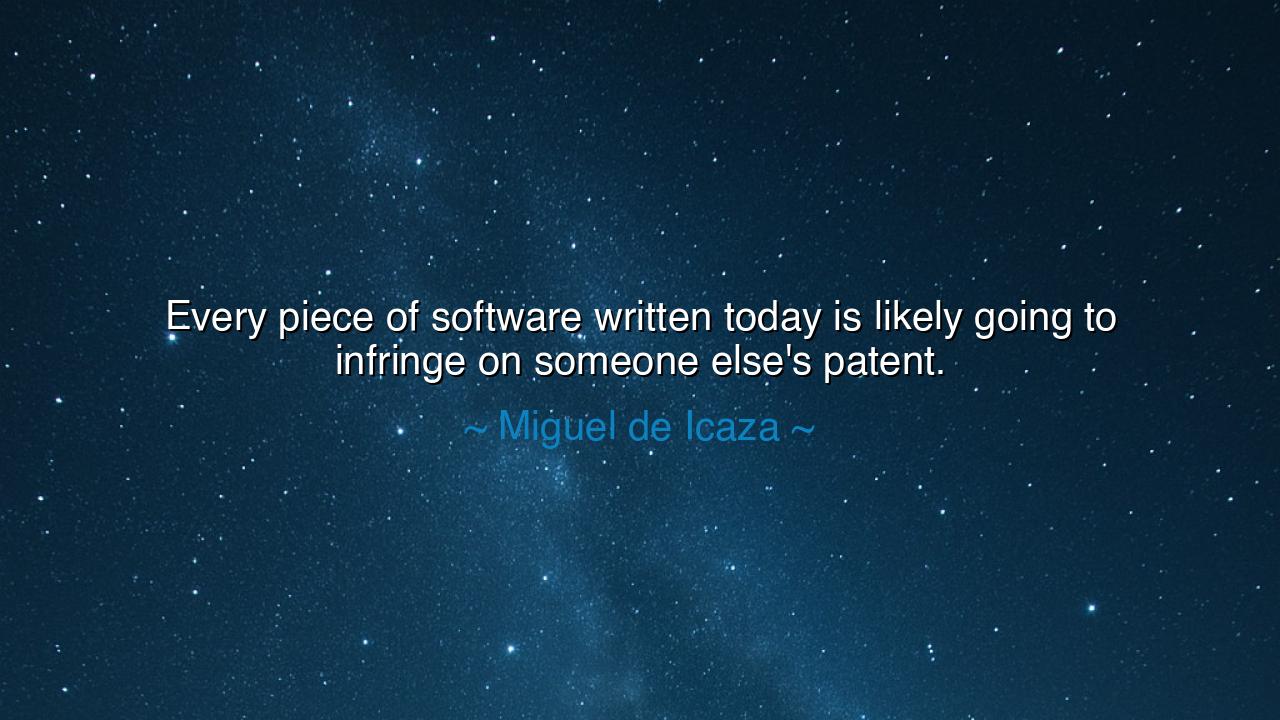
Every piece of software written today is likely going to infringe
Every piece of software written today is likely going to infringe on someone else's patent.






In the ever-evolving landscape of technology, where each line of code is built upon the foundations of those that came before it, Miguel de Icaza’s words carry a sharp truth: “Every piece of software written today is likely going to infringe on someone else’s patent.” This statement, though born of the world of technology, resonates deeply with the ancient truths of human creation. It is a reminder that innovation does not exist in isolation. Every act of creation is a thread woven into a much larger tapestry, where ideas, inventions, and knowledge are shared and reshaped across generations. Just as Greek philosophers built upon the work of those who preceded them, so too does modern software build upon the intellectual labor of others.
Icaza's quote speaks to the very heart of the creative process. Innovation, in the world of software, is not about a solitary genius working in isolation, but about collaboration, borrowing, and adapting what has come before. In a world where patents—those legal protections for the intellectual labor of creators—become the measure of ownership, it is easy to forget that every new idea is often just a recombination of those that have come before. This truth, though uncomfortable, reflects a larger reality about human endeavor: nothing is truly new. Every creation is part of a long chain of influence, a reflection of the interconnectedness of ideas that stretch across time and space.
This is not a concept foreign to the ancients, who saw the process of learning and creation as an interconnected journey. Aristotle, the great philosopher, understood that knowledge was not a static thing but a living organism that grew through dialogue and exchange. Each new thinker, each new creation, stood upon the shoulders of giants, acknowledging the debt owed to those who came before. Icaza’s words remind us that, much like the philosophers of old, the work of today cannot be understood without recognizing the labors of those who came before. The software of today is but another manifestation of this ancient truth.
Consider the example of Thomas Edison, whose name is forever linked to the invention of the light bulb. While Edison is often credited with bringing the light bulb to life, the reality is far more complex. His work was built upon the knowledge of countless others, including Michael Faraday, who had explored the principles of electromagnetism, and Joseph Swan, who had developed an early version of the light bulb. Edison’s genius lay in his ability to synthesize these ideas and create something that was both functional and revolutionary. Yet, in the modern world, Edison's innovations might well have been seen as infringements on the patents of those who had come before him. And so, Icaza’s statement holds true: innovation is an act of synthesis, a weaving of the old into the new.
This reality of patents and intellectual property has become especially poignant in today’s digital age, where software development is a continual process of borrowing and building upon. In the vast world of technology, it is easy to see why patents can sometimes feel like chains, restricting the flow of creativity. Yet, intellectual property also serves as a reminder of the value of ideas, that human creativity must be respected and protected. Icaza highlights a tension inherent in the creative process—how can we ensure the free flow of ideas, while also honoring the work of those who paved the way?
In the world of software, where every new app, website, and system is a product of collaboration, this tension plays out daily. Each line of code is a fragment of the past, drawn from libraries, tools, and patents long established. And yet, the spirit of innovation is relentless. It compels creators to push boundaries, to reimagine and recombine the familiar into something that has never been seen before. This drive to create something new, even when it is built upon the shoulders of giants, is the essence of human progress. As the ancients believed, the true power of innovation lies not in the creation of something entirely new, but in the re-imagining of what has already been given.
Lesson for the ages:
In every creation, whether in software, art, or science, there is always an interconnectedness to the past. Innovation does not happen in a vacuum; it is a continuation of a much larger journey, one that stretches across generations. To truly innovate, one must honor those who have come before, acknowledging the debt we owe to their work. Intellectual property, while important, should not become a barrier to creative expression but a means to ensure that the spirit of creation is respected and protected.
Practical Action:
As you embark on your own creative journey, whether in software development, design, or any other field, remember that you are part of a much larger chain of influence. Respect the work of those who came before you, but also feel free to synthesize, to reimagine, and to build upon their ideas. Seek not to reinvent the wheel, but to improve upon it, making it stronger, faster, or more efficient. And in doing so, be mindful of the patents and intellectual property that protect the rights of those who helped shape the world you now live in. For in this, we honor both the spirit of creation and the power of progress.






AAdministratorAdministrator
Welcome, honored guests. Please leave a comment, we will respond soon